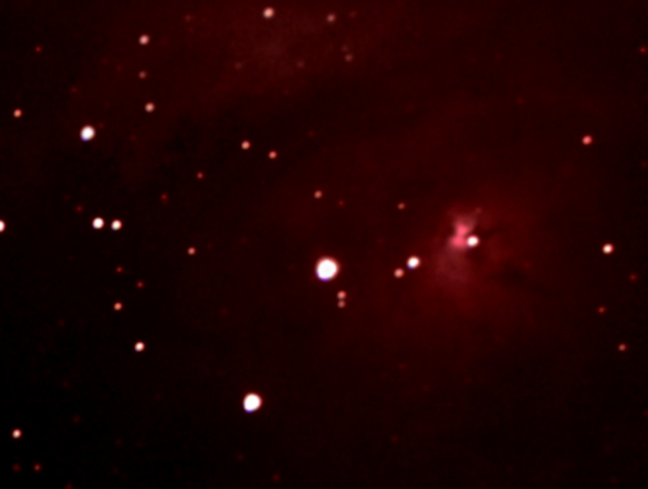
M8: Lagoon Nebula

RA: 18h 3min 48sec Dec: -24º 28' 00" Mag: Distance: 5000 light years Constellation: Sagittarius
This photo was taken on the 28th of August 2005 between 11pm and 12am. M8 never achieves much elevation at my location even at its highest point and so I not only have the atmosphere and haze over the horizon to contend with, but also my neighbour's trees. Because of the overall size of M8, you really need to take it at f3.3 or at any rate, less than f.6.3 which is my maximum field of view. Nevertheless, I was amazed at the amount I could get at the heart of the nebulosity with the minimal exposure time. This is the end-result of 15 x 40 second exposures stacked by Envisage - the programme that works as part of Autosuite, and which drives the DSI. (I had just aquired the equatorial wedge and was trying out the steadiness of the image - there was some minor drifting of the image on the vertical axis but I was gratified to find no rotational lengthening of the peripheral stars whatsoever, and the tracking function of Envisage compensated for the slight vertical drift) Considering the best amateur photographs of this area at the heart of our Milky Way galaxy are the result of 1 or more hours of exposure time, I thought it was great that I could demonstrate the dark dust trail in the nebula (in this case running from the top edge of the photo diagonally to the lower left edge) with just 10 minutes of exposure time in total.
The raw image was processed solely in Adobe Photoshop 7.0. Under the Levels function, the histogram was stretched to the same extent for R, G and B, retaining the high ratio of R to the other two primary colours. Midtones were increased using the Curves function which unfortunately also caused the stars to 'bloom' slightly, and finally, the dark contrast was increased by stretching the histogram further with the black level input setting for luminosity (RGB): moving it to the right hand slightly, taking care not to the reduce the glow of the nebulosity which had previously been enhanced with the midtone boost. No Unsharp Mask nor Gaussian Blur was used.
Problems: a) unable to take longer exposures because trees get in the way, b) the slight vertical drift of the image in spite of taking great care to align the telescope well (the Meade instruction leaflet is woefully inadequate in describing the home position for the telescope when using it in equatorial mode, in Appendix C) and c) it might have been nice to deconvolve the image to get a better appearance for the stars. (This is a recurring situation which I refer to under 'Software' in greater detail)
HOME PICTURES: Deep Sky PICTURES: Solar system PICTURES: Wide field